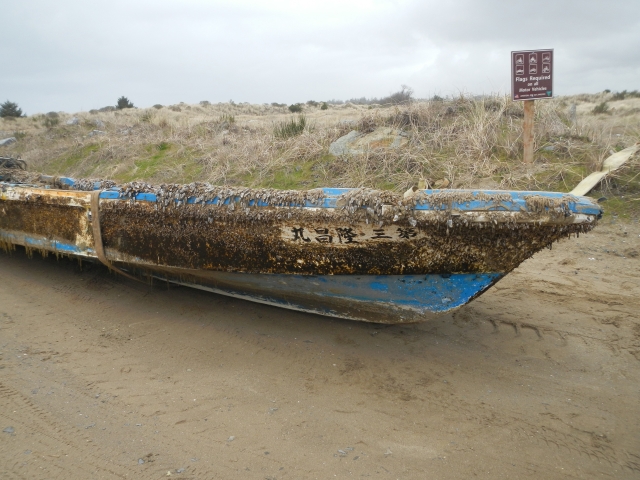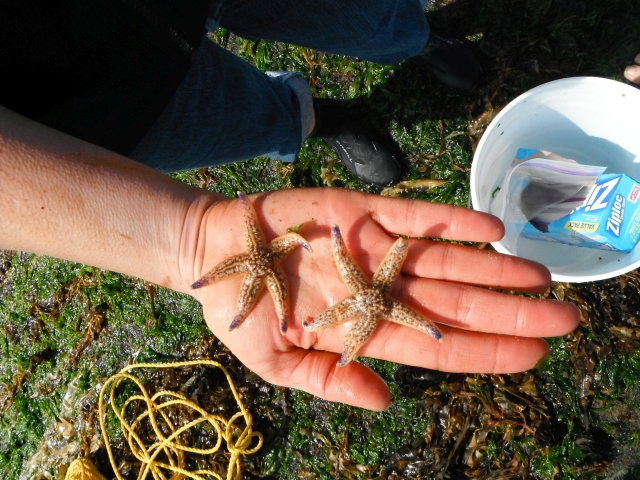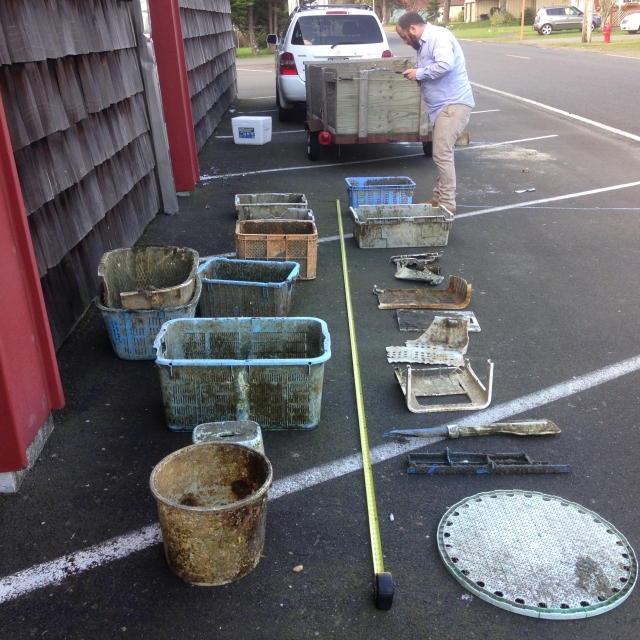
by Alex Lopatka Tuesday, November 21, 2017

This Japanese boat washed ashore in Oregon, carrying a load of nonnative species, following the 2011 Tohoku earthquake and tsunami. Credit: John W. Chapman
Since World War II, fiberglass and plastic — which are stronger, lighter and require less maintenance than wood — have become the materials of choice for coastal infrastructure like docks. An unforeseen consequence of this transition, however, is that when structures built from these durable materials break free from their moorings and drift out to sea, they can serve as resilient rafts for opportunistic organisms. In a new study in Science, researchers document hundreds of marine species that made their way 7,000 kilometers across the Pacific Ocean from Japan on debris — much of it made of plastic and other modern materials — following the magnitude-9 Tohoku earthquake and tsunami in March 2011.

Japanese sea stars (Asterias amurensis) were among the creatures that arrived to Newport, Ore., in 2012 aboard a large dock that crossed the Pacific from Japan. Credit: John W. Chapman
There is “no precedent for this in marine science: a debris field [with a precisely] known origin and known time of entry into the sea,” says James Carlton of the raft … it turns out these species can survive much longer than expected … established populations were found on these rafts."
In total, the researchers documented 289 distinct living species on the debris, including mussels and other mollusks — which constituted the largest group observed — as well as crustaceans, fish, protists and others, “none of which were previously reported to have rafted transoceanically between continents,” they wrote.
Species rafting “happens all the time, but rarely on such a massive scale,” says Martin Thiel, a marine biologist at the Catholic University of the North in Chile. “This is really exciting work,” Thiel says; the researchers “succeeded in gathering a large dataset” that will be useful for many years to come.
Thiel notes that, based on the species documented in this study, certain attributes and behaviors seem to contribute to the ability of some species to survive long ocean voyages. For example, relatively small and immobile animals such as oysters, which attach themselves to surfaces, are better adapted for a long journey on a plastic raft, Thiel says. Filter feeding animals that don’t rely on capturing prey, are also better adapted for rafting. Lastly, organisms with short adolescent stages, which require fewer resources to fully mature, are better suited to life on a raft floating across the open ocean, where nutrients are limited compared to coastal environments. Carlton says some of these species “may be tapping resources in ways we don’t quite understand yet.”

Researchers examined hundreds of pieces of debris — many made of plastic — that made their way to North America from Japan after the tsunami. Credit: John W. Chapman
Species rafting by marine organisms on construction materials hasn’t been a major concern during modernization of coastal infrastructure. When the last major earthquake-induced tsunami impacted Japan in 1933, the Japanese coast and the coasts of other developed nations looked far different than they do today, and wood was the main building material. Today, organisms have more durable objects to cling to.
To limit the amount of debris that gets into the oceans, Thiel suggests strict measures to reduce marine litter. “What we can do is be more careful [and] thoughtful about what we dump in the ocean,” he says, as well as where we build along coastlines, and how we plan for natural hazards in modern construction.
The threat of invasive species is a problem at “the heart of marine debris science,” Carlton says. There is “a long list of invasive species … that have had a remarkable impact on the environment and economy,” he says. “Before they invaded, they were completely off our radar. We [didn’t] know they could become nuisance species.” But figuring out which, if any, of the non-native species that have recently rafted from Japan to North America will become problematic is an “extremely hard question to answer,” Carlton says, in part because there’s an element of chance to it. It’s a kind of “biological roulette,” he says.
For bivalves that clung to rocky shores and solid docks in Japan, for example, “the sandy shores [where they landed in Oregon] are like a desert,” Thiel says, lacking the ideal environmental conditions for their survival and reproduction. But their odds of success could be higher if they landed on a rockier part of the North American shoreline. The challenge for researchers will be in trying to determine the ability of a non-native species to thrive in a new environment.
© 2008-2021. All rights reserved. Any copying, redistribution or retransmission of any of the contents of this service without the expressed written permission of the American Geosciences Institute is expressly prohibited. Click here for all copyright requests.